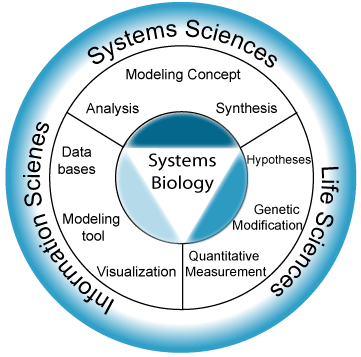
| Home |
| About |
| People |
| Links |
| SysBio? |
| Research |
| Projects |
| Pubs |
| Suppl. |
| Education |
| Courses |
| Theses |
| Info |
| Publicity |
| Talks |
| Jobs |
| Impressum |
|
|
What is Systems Biology?
 The emerging area of systems biology is a whole-istic approach to understanding
biology (Chong and Ray 2002). It aims at system-level
understanding of biology, and to understand biological systems as a system.
This means an examination of the structure and dynamics of cellular and
organismal function, rather than the characteristics of isolated parts of
a cell or organism (Kitano 2002). Many properties
of life arise at the systems level only, as the behavior of the system as
a whole cannot be explained by its constituents alone.
The emerging area of systems biology is a whole-istic approach to understanding
biology (Chong and Ray 2002). It aims at system-level
understanding of biology, and to understand biological systems as a system.
This means an examination of the structure and dynamics of cellular and
organismal function, rather than the characteristics of isolated parts of
a cell or organism (Kitano 2002). Many properties
of life arise at the systems level only, as the behavior of the system as
a whole cannot be explained by its constituents alone.Prominent examples for biological systems are the immune system or the nerve system, which already have the word system included, but system-level understanding is still far away. Although the idea of system-level understanding is not new in biology (Wiener 1948; Bertalanffy 1969), the renewed interest can be assigned to the breakthrough advances in molecular biology in the last decades, providing new data, enabling applied work in this area, making the in silico model of an organism envisionable.
As explained, the biological knowledge is growing very rapidly, and data analysis can hardly keep pace. In the bioinformatics area, tools have been developed and will be advanced to handle the huge and rapidly growing amount of data stored in databases. One main effort is to group and compare data, to gain information about single molecules compared to similar molecules. In structural biology there are efforts to predict the three dimensional structure of proteins and DNA based on homology (so again by comparing) and de novo. In the latter case, the interaction between atoms within a molecule is modeled and advances in computer hardware make work intensive simulations possible. Simulation for de novo structure prediction has had limited success so far, but, for example, is already successfully applied in the refinement of experimentally defined structures (bioinformatics overview in the lecture and practical manuals from the Institute of Technical Biochemistry, Stuttgart).
Systems Biology takes a different approach and tries to integrate the biological knowledge and to understand how the molecules act together within the network of interaction that makes up life. Again, model building promises to be the key in advancing understanding. The exploding amount of biological data, and the judgment that it cannot be understood by simply drawing lines between interacting molecules explain the demand for a systematic approach. The expectations are highlighted by numerous articles in leading scientific journals (e.g. Science Special, March 1st, 2002), numerous centers devoted to Systems Biology being opened worldwidea, and other research collaborations bringing together expertise in mathematics, information science and biology being funded.
However, most of the biological data so far are qualitative rather than quantitative and probably many breakthroughs in experimental devices, advanced software, and analytical methods are required before the achievements of systems biology can live up to their much-touted potential (Kitano 2002). Whereas many of the so-called system biology approaches still focus on data mining, the integration, processing, representation and analysis have to be considered, as breakthroughs are needed on every level.
Nevertheless, systems biology is needed and modeling approaches are powerful in principle. The huge amount of data is familiar to engineers, for example, those designing control systems for modern passenger jets (Csete and Doyle 2002). Model building as an aid to understand complex systems is also the method of choice in areas like ecology or economy. Therefore, the promises are worth the effort and lessons from system analysis of advanced technologies and engineering theory suggest that the systems can be divided into subsystems, so one does not have to tackle and solve the whole system at once.
» The very basics of Molecular Biology
» The very basics of Modeling